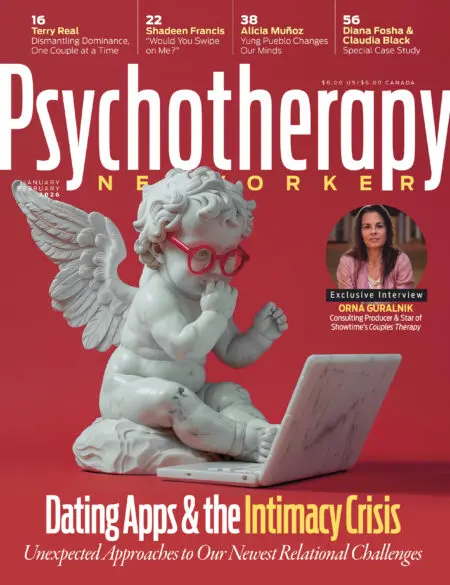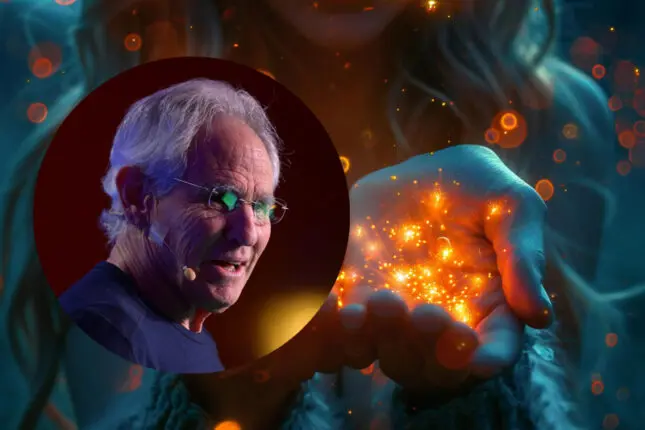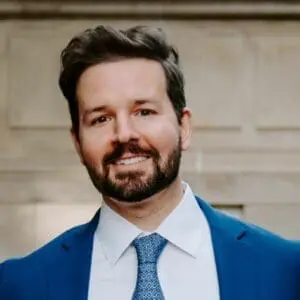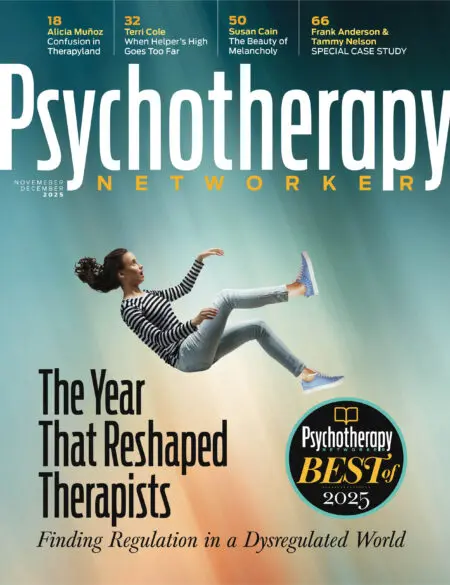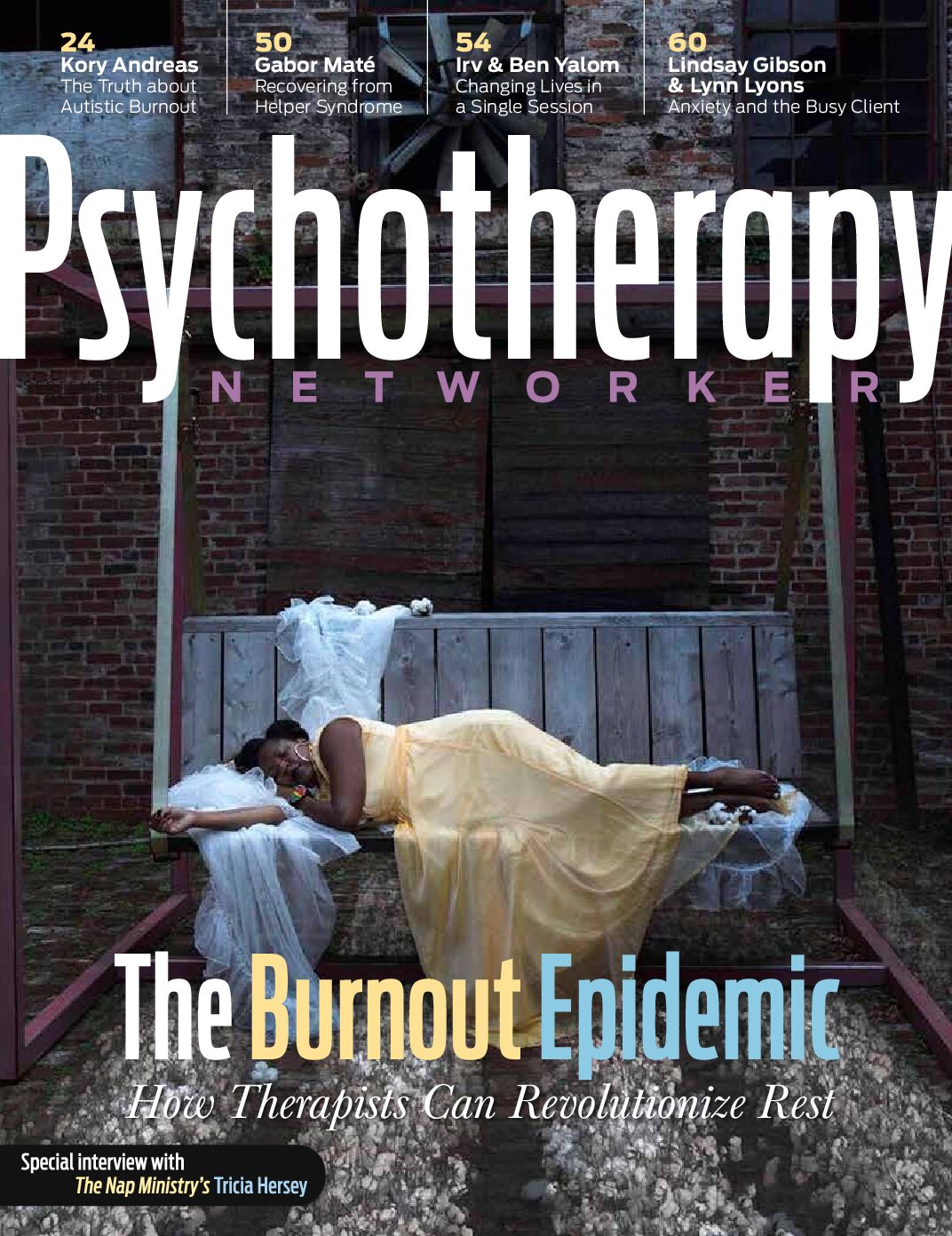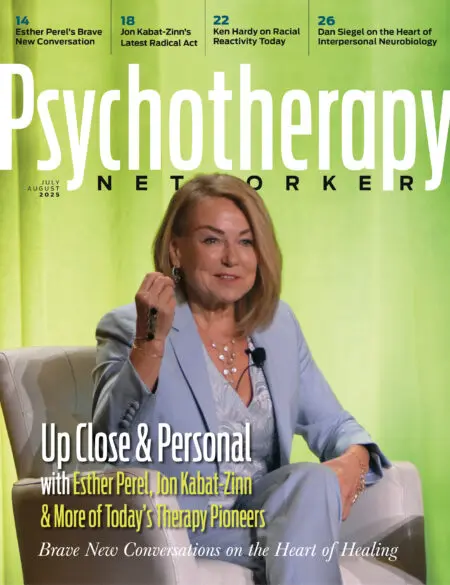Enjoy the audio version of this article—perfect for listening on the go.
Barely a minute into taking the main stage at the 2025 Networker Symposium, Jon Kabat-Zinn is already being disruptive—in the most Buddhist of ways.
“The first thing we always did with Mindfulness Based Stress Reduction groups at the hospital was move the furniture,” he says, taking hold of a chair and side table that had been arranged just-so for his keynote. The audience chuckles as he shifts them a few feet. He picks up a large purple meditation cushion, ponders for a moment, and then drops it back onto the floor with a plop, apparently satisfied with the new feng shui.
“Moving the furniture is a radical act,” Kabat-Zinn continues, cupping a hand over his brow and peering out into the crowd. “I think it’s really important to do what we can to rearrange things, but there are limits to that,” he adds with a wry smile. “The deck chairs on the Titanic? That’s another story.”
Jon Kabat-Zinn has become well-known for his cryptic wordplay over the years, for the clever idioms, sly metaphors, and nuggets of sage wisdom you can quickly unwrap and savor like some sweet morsel: intellectual but unpretentious. Many who’ve had The Jon Kabat-Zinn Experience can attest to being tickled like this, but also to being transported someplace deeper—even transcendent. With a long list of accolades and celebrity endorsements, Kabat-Zinn’s reputation easily precedes him.
What can anyone really say about the man that hasn’t already been said? About the New York kid who found himself blazing trails at MIT? The meditation student who became a molecular biologist? The Vietnam War protestor who sat shoulder-to-shoulder with Noam Chomsky? The founder of Mindfulness Based Stress Reduction (MBSR)—now used by more than 700 hospitals worldwide? After all, this is “the Godfather of Modern Mindfulness” we’re talking about, the reason countless therapists and clients all over the country, on any given day, close their eyes, take a breath, and turn inward in their search for answers and healing.
Kabat-Zinn recently celebrated his 80th birthday, and even though he moves and speaks with the vitality of someone half his age, he’s still confronting some hard truths. He no longer meditates the way he did in his younger years, he recently confessed on Rick Rubin’s podcast, Tetragrammaton. “I still love it in the same way,” he told the Grammy-winning record producer, “but as I’ve gotten older, I’ve gotten a lot more relaxed about the heavy-duty discipline”—trading 4 A.M. meditation sessions on the floor for late-morning sessions in bed, and more complex yoga poses for gentler ones, like “lying on my belly and pretending I’m swimming.” His cultural protest days are far behind him too, as are the days when he’d lead hundreds of avid meditators in public parks. “There’s that law of impermanence,” he told Rubin. “If you have a body, it goes through changes, and ultimately, it dissolves back into the elements.”
All very noble, yes. But let’s face it: it’s hard to imagine a world without Jon Kabat-Zinn. Who else can tend to the mindful flock with such aplomb? Who’s going to give us comfort and guidance in our darkest hours, when there seems to be every indication that our society is collectively barreling toward unprecedented social, economic, environmental, and political crises—when the ability to tap into an inner refuge won’t just be an elective, but a necessity?
Kabat-Zinn’s most “radical act” may in fact be a disappearing act, but it couldn’t come at a worse time. American mindfulness is facing an identity crisis: the rise of McMindfulness. In the race to make therapy faster, more cost-effective, and more evidence-based, it sometimes feels as if we’ve lost our grip on what it really means to be mindful: that we’ve turned meditation into just another tool, or boiled it down to its most sedimentary components—the breath, the body, the mind—and lost its heart and soul in the process. If we’ve strayed from the mindful path, how do we find our way back home?
Granted, it’s unlikely that anyone in the audience is racking their brain over any of this right now. Between their raptured attention and scribbling pens, it seems that people are simply enjoying themselves. But there is a sense of anticipation, a palpable hunger for whatever journey Kabat-Zinn is about to take us on, and I begin to think that if our culture is overdue for a mindful realignment, maybe he’s exactly the kind of spiritual chiropractor we need. Wrinkles and grays be damned—nobody does it quite like Jon. Gazing out at the crowd with his sleeves rolled up, it’s hard not to feel a sense of optimism, like mindfulness’s Prodigal Son has finally returned.
The Many Selves of Kabat-Zinn
If you know where to look, you can find segments of an old 1982 VHS tape that doctors used to show patients lying in their hospital beds. The Art of Relaxation opens with a few plucky notes of harp music before fading with a crackle into a shot of Kabat-Zinn at just 38 years old. It’s been three years since he founded the Stress Reduction Clinic at the University of Massachusetts Medical School—effectively bridging the gap between medicine and mindfulness—and he’s dressed accordingly, sporting a slightly baggy, baby blue dress shirt, a burgundy tie, and dark hair coiffed like a young Kennedy. His face is thin and angular, sharpened by the ink-black room he’s sitting in. Absent are any yoga mats, or meditation bells, or any tangible signs of the Jon Kabat-Zinn the world will soon come to know. Still, there’s a certain magic in watching a legend before their prime, in spotting embryonic versions of the phrases and mannerisms that will survive and grow and become part of someone who appears as close to self-actualization as humanly possible.
But this man in the crackling video—The New York Kid, The Doctor, The Scientist, The Rebel, and The Philosopher all rolled into one—is without a doubt the same man onstage today. And it’s not just the look that’s the same—that no-nonsense, brow-furrowed, lips-pursed expression that Kabat-Zinn wears like one of those big Easter Island statues—but his cool confidence, and seemingly effortless ability to grapple with life, death, and everything in between—and bring you along for the ride.
“The full catastrophe of the human condition,” Kabat-Zinn tells us, “is not all bad—it’s the totality of the good, the bad, and the ugly. You’d better learn how to inhabit the present moment, because it’s all you’ve really got. But now doesn’t have to be oppressive, or a weight you’re carrying. Liberation is possible.”
How? Well, meditation. It’s actually a form of medicine, Kabat-Zinn explains. “They’re linked at the etymological hip,” he says. Clever. “You’ll notice that your mind is almost never in the present moment. It’s a dis-ease.” Clever again. “I wanted to do meditation and get paid for it,” he jokes about his origins. But really, he says, the hope was to catch people falling through the cracks of the healthcare system, “to invite them to see if there was something they could do for themselves that nobody else on the planet could do for them.”
By now, Kabat-Zinn has been cupping his hand over his brow for a while. Those stage lights can be oppressively bright. But then, a nameless savior emerges from the crowd, tiptoeing toward the stage and tossing a maroon baseball cap into Kabat-Zinn’s hands.
“Ohhh, this is fantastic!” he declares, turning it over as the audience erupts in cheers. “It’s not a Red Sox hat—but I’ll take it!” he announces decisively, fitting it around his head. “I’ve been with the Dalai Lama in many situations where he’s onstage and can’t see a thing. In fact, can we turn up the house lights so I can actually see your eyes?”
The room brightens.
“Ohh, that’s so much better!” he exclaims. “I haven’t forgotten that you’re here,” he tells the audience. “I know you’re here.” He pauses for a moment before adding a bit of Buddhist humor that makes everyone burst into laughter: “But I doubt it.”
The Mortal Master
It’s easy to watch Kabat-Zinn in moments like these and feel like you’re getting the real thing: not Jon the Keynoter, or Jon the Entertainer, but the same guy you might meet at the dog park, or the baseball stadium, or in line at the coffee shop. He’s refreshingly down-to-earth. At one point, he walks over to a pair of meditation cushions that have been procured for him: one small and circular, the other large and rectangular. “This is called a zafu in Japanese,” he says, dangling them each from a finger. “And this is called a zabuton.” He lets them fall to the stage with an unceremonious flump. “And you don’t have to use either of them.”
Kabat-Zinn seems authentically, unapologetically himself at this stage of life, confident enough to ad lib, moving from quips like “But I doubt it” to something kind of similar, but different. “As the Zen people say,” he shifts, “little doubt, little enlightenment.”
This linguistic wandering with Kabat-Zinn isn’t some lecture from on high. These are free-flowing, imperfect musings from someone who could be your friend, or neighbor, or perhaps a wise uncle. And it’s precisely this blend of intelligence and humility that explains Kabat-Zinn’s enduring gravitational pull, why so many who listen to him talk about mindfulness find themselves practically hypnotized.
Kabat-Zinn keeps going: “Now, the E-word is seriously problematic,” he tells us, “so you can expunge it from your vocabulary, and I will not use it again. But it has everything to do with whether you’re actually awake in the only moment any of us ever have.” He pivots again: “Or as Thoreau so famously said, ‘I went to the woods because I wished to live deliberately, to front only the essential facts of life and see if I could not learn what it had to teach, and not, when I came to die, discover that I had not lived.’ Thoreau realized that it’s very easy to miss the present moment,” he adds, “and that’s what meditation is. It’s an invitation to drop into now.”
By this point, most of the questions I had coming into this event—about the cultural unravelling of mindfulness, or who’s going to lead the next generation of meditators, or even the chaos raging in the world outside—have evaporated. Right now, I’m spellbound. But then, as if through some mystical feat of Buddhist telepathy, Kabat-Zinn reorients me to one of my most burning questions: What is mindfulness, anyway?
“What is mindfulness? I can give you two answers. The first one is awareness,” he says before blowing a raspberry. “Bo-riiing!” The audience laughs. “The second angle is relationality. How are you in relationship? It’s hard to wrap your thinking mind around relationality,” he continues, “because it’s so mind-blowing. Every moment is pregnant with the possibility of embodied wakefulness.”
Equating mindful awareness with birth. It’s a beautiful metaphor. Then, Kabat-Zinn performs another act of spiritual wizardry, turning to a different salient topic: aging and death. His aging and death.
“The law of impermanence is always at work,” he says, lacing his fingers. “If you’re fortunate enough to reach a certain age where the glide path out becomes undeniable,” he says with a swooping hand, “accepting that becomes part of your practice. It’s become part of my practice.” Then, things take an even more personal turn.
“My grandchildren will say, ‘Grandpa, you’re old’,” he continues, his lips curling into a mimicking sneer. Then, his face softens. “I say, ‘I know.’ And they ask, ‘Are you going to die?’” He folds both arms across his chest. “And I say, ‘Yeah, yeah. I’m gonna die’.” He pauses for a moment. “‘But not now.’” The audience is silent, the moment profound and bittersweet. But we don’t linger here long. Kabat-Zinn uncrosses his arms and laces his fingers once again.
“Part of the challenge of mindfulness,” he continues, “is not worrying about dying, but actually being alive, in this only moment, instead of zooming through it on autopilot to get to some fictious ‘better’ moment at some later time—and then waking up like Thoreau, right before the end, and realizing that we haven’t lived.”
Mindfulness, Kabat-Zinn seems to be saying, isn’t just some useful therapeutic tool, or a thing to be slipped on and off when it’s convenient, like some sort of spiritual sport jacket. It’s a state of being, a compass for life.
The Song Goes On
As the journey with Kabat-Zinn continues, we take more gentle twists and turns. Gracefully, he takes a seat on the meditation pillows (“a radical act of sanity and love”), and waxes lyrical on MBSR (“it’s everything: it’s not doing”), ancient Chinese mindfulness traditions (“second to nothing in their beauty”), and self-acceptance (“what if you’re good enough now, exactly the way you are?”). He reflects on his protest days (“the ’60s were a lot like now”), children (“it’s very important to see them as Buddhas”), and even pronouns (“the problematic ones are I, me, and mine”). There are periodic moments of beauty, as he effortlessly recites poetry from Walcott, Dickinson, and Chaucer by heart.
By the time he uncrosses his legs and pushes up off the ground with the grace of an Irish riverdancer, he’s in the thick of a sermon about the “polycrisis” we’re facing, an epidemic of rampant social division and waning empathy. Then, he poses The Big Question: “How do we thread the needle to sanity in an insane world?”
At this point, I have no doubt that everything Kabat-Zinn embodies—an impossibly rare combination of wisdom, compassion, self-insight, poetry, and street-smart straight talk—is exactly what the world needs right now. We need a Jon Kabat-Zinn in the halls of Congress. We need a hundred in every hospital. We need thousands in the thick of war-torn countries, passing out food and medicine and poetry. We need someone who won’t just restore the heart and soul to mindfulness, but to our collective humanity. And this morning proves it: Kabat-Zinn is the man for the job, and he’s still got plenty of gas in the tank. But will he lead the charge?
The truth is: probably not. For all the many selves of Jon Kabat-Zinn I’d accounted for, there’s a crucial one I’d overlooked: The Reluctant Hero.
“You could write the story of me a million different ways depending on your angle,” he says. “But it’s not about the story, it’s about how we are in relationship,” he says, extending a hand toward the audience. “Just looking at your faces and feeling that we’re in the moment together, on the same wavelength, you inspire me.”
Between all the books you’ve read and the talks you’ve heard, you may think you know Jon Kabat-Zinn. But the likelier truth, I’ve realized, is that you probably don’t. After all, he says, we’re constantly, unconsciously, erroneously assigning labels to people. He’s not Jon the Rescuer, or Jon the Guru, or even Jon the Meditator. He’s just Jon.
So without a captain behind the wheel, how do we thread the needle to sanity in an insane world? And what about the rise of McMindfulness? How do we find our way back to what meditation is really about? Over two hours, Kabat-Zinn shared some moving stories and sublime poetry. He helped us slow down and take a breath. No doubt many therapists will walk away from this experience with some quotes in their back pocket, feeling lighter on their feet and renewed passion for their work. Is that enough?
For now, yes. After all, as Kabat-Zinn says, the mindfulness movement has never really been about him; it’s been about us. He’s been telling us all along, ever since he filmed that grainy VHS tape 43 years ago: I can point the way, but the rest is up to you. You are the source of your own divine healing.
“When you take your seat,” he says, “it’s not about pretending to be enlightened. You don’t need to pretend, because you already are.” Pivoting once more, he invokes poet Rainer Maria Rilke:
“My life is not this steeply sloping hour in which you see me hurrying. Much stands behind me; I stand before it like a tree; I am only one of my many mouths, and at that, the one that will be still the soonest. I am the rest between two notes, which are somehow always in discord because Death’s note wants to climb over. But in the dark interval, reconciled, they stay there trembling. And the song goes on, beautiful.”
“The song is you,” Kabat-Zinn tells us. “The song is life.”
Chris Lyford
Chris Lyford is the Senior Editor at Psychotherapy Networker. Previously, he was assistant director and editor of the The Atlantic Post, where he wrote and edited news pieces on the Middle East and Africa. He also formerly worked at The Washington Post, where he wrote local feature pieces for the Metro, Sports, and Style sections. Contact: clyford@psychnetworker.org.
